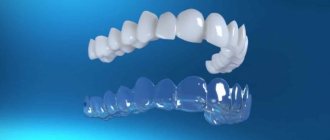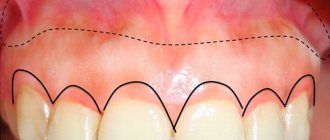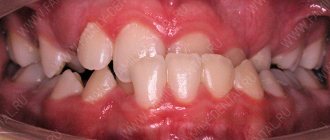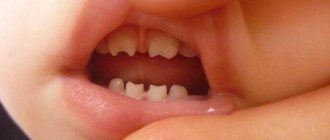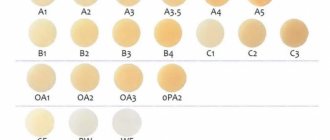Restoration with crowns is one of the options for restoring lost teeth. Installing a crown allows you to equally effectively restore both the functionality of the tooth and its aesthetics. Crowns can be recommended for installation on a tooth even if it has undergone severe destruction due to caries (more than 50%).
Installing crowns is a multi-stage procedure that has its own characteristics, which you can learn about in detail from this article. The material will introduce you to the indications and contraindications for installing dental crowns, tell you about all stages of the treatment process, and the types of crowns that can be used for dental restoration. Also in the article we will talk about whether it hurts to put a crown on a tooth and how you can remove the prosthesis from the tooth if complications arise after prosthetics.
What is preparation or grinding of enamel: a complete list of indications for this procedure
Article navigation
- What is preparation
- What preparation is needed before turning?
- Types of turning
- Peculiarities of turning for different types of prostheses
- Types of ledges when fixing crowns
- Features of the procedure in children
- Will it hurt when turning?
- What to do if there is pain after turning
- Is preparation always necessary?
- How much will the turning cost?
Question to a specialist
To restore “problematic” or missing teeth, we go to an orthopedic dentist who offers various prosthetic options. However, the installation of a veneer, crown, removable dentures or bridge is almost always preceded by dental grinding - and the very mention of it immediately frightens patients. What kind of procedure is this, in what situations is it used, will it hurt, what are the features of the preparation and how the process works in patients of different ages - all this is discussed in today’s material.
How is a crown made?
Many patients wonder how long it takes to have metal-ceramic dental prosthetics. It is important to understand here that the procedures for preparing the teeth and the installation itself are carried out quite quickly, but the manufacture of the structure takes longer. As a rule, 1-2 weeks are enough to make a metal-ceramic crown. Based on the casts created, specialists make a plaster model - it is cast according to the impression after a preliminary assessment of its quality.
Then a dental laboratory specialist models a framework for metal-ceramics using wax. The finished frame is fixed on a plaster model and sent to an orthopedic doctor so that he can try it on in the patient’s mouth.
Then ceramic mass is applied to the frame. Before this is done, it is fired in a kiln and sandblasted - this allows for better adhesion of the metal and the ceramic mass.
The opaque is applied first - this is an opaque composition, then the structure is covered with a dentin layer (more transparent), and then with an enamel layer. This technology makes it possible to recreate the natural appearance of a tooth, taking into account the individual characteristics of the color of the enamel of your own teeth.
After the patient has tried on the design, glazing and final firing are carried out - then the crown is installed.
What is preparation
At its core, the preparation process involves removing part of the hard tissue. This layer, represented by enamel (the outer shell) and dentin (these are the internal tissues), must be equal to the thickness of the prosthesis. Armed with a bur, the doctor cuts off the excess and gives the crown the shape on which the prosthesis will easily and reliably fit. It is important to ensure maximum density and absolute accuracy of its fit. As a rule, the shape of a natural tooth is a cone or cylinder.
Relatively speaking, you will have to “cut off” the amount that is equal to the thickness of the prosthesis. For example, zirconium dioxide will require minimal grinding, but metal-ceramics (after all, there are both ceramics and metal) will require the removal of a thicker layer of living tissue.
Preparation is also carried out during filling, but in this case only inflamed tissues are removed, while healthy ones are preserved. If you need to install a prosthesis, even living tissue will have to be removed.
Removing dental crowns: indications and features of the process
Removing dental crowns is a procedure that becomes necessary if certain complications arise after installing the prosthesis. Removal of the structure may be required in situations:
1. Poor quality preparation for dental crown prosthetics. If the tooth canals are poorly cleaned and poorly sealed, then an inflammatory process may begin to actively develop in them. If such a process occurs, the crown will need to be removed and the tooth treated or removed.
2. Inaccuracies in the manufacture of a crown on a tooth, in which the installed structure will overestimate the bite and not fit tightly to the tooth.
Crowns are also removed for planned replacement. High-quality structures can last up to 10 years or more, but after that the crown will be replaced with a new orthopedic product. Crown removal may be uncomfortable for the patient, so it is usually performed using local anesthesia. To remove the structure, it is sawed with a bur, removed, and those medical manipulations that are necessary for a particular case are performed.
We hope the material helped you learn all the important nuances of installing crowns on your teeth, and you can always get more detailed advice on prosthetics from the dentist at our Vanstom clinic in Moscow! To make an appointment, just call us!
What preparation is needed before turning?
In order to secure the future prosthesis well, the prepared crown must be strong, free of plaque and stone, and free of carious lesions (if any, the doctor will, of course, remove them first). Also, before treating the enamel under any prosthesis, it is important to remove soft and hard plaque.
Only until 15.01 South Korean implant Osstem - from 18,500 rubles.
Hurry up to sign up for a free consultation and lock in promotional prices.
Call now or request a call
Opening hours: 24 hours a day - seven days a week
Preparing to install dental crowns
Traditionally, crowns are placed on dead (pulpless) teeth, but sometimes there is a need to install a structure on living teeth. This has a positive effect on the final result of prosthetics, since living dental units are stronger and less susceptible to destruction processes, which ensures a long useful life of the crown. Usually, chewing teeth are not depulped during prosthetics. They have a significant area of the natural crown and the distance from the enamel layer to the pulp is greater, which eliminates burns to the natural tissues of the oral cavity during prosthetics.
Types of turning
The choice of technique depends mainly on the individual clinical picture, as well as on the volume of tissue that needs to be trimmed. There are types that are more extended in time, and there are very fast, safe and pass without the slightest pain. Let's look at all of them that currently exist. But keep in mind that the choice always remains with the attending physician, who will assess the situation and select the most optimal option.
Ultrasonic
This method involves the use of a special apparatus that produces high-frequency vibrations - ultrasonic. And the device itself is called a “scaler” or “scaler”. By the way, it is used to clean enamel from plaque. Also, instead of a scaler, a piezo device can be used - its action is again based on the use of ultrasonic waves, but they are more powerful, which allows it to be used on harder tissues.
During the procedure, the doctor does not touch the enamel with the instrument. Almost no heating occurs. So the risk of damage disappears. As for pain, it may well occur if there is increased sensitivity, so anesthesia will be appropriate. The method makes it possible to dissect only a small volume.
Laser
This is another effective non-contact turning method. The laser acts on the enamel pulsed, but again removing only a very small layer of enamel and inner dentin. By the way, unlike ultrasound, this method is safer, since laser beams have a wound-healing effect. The method is absolutely silent and allows you to quickly achieve the desired result.
Preparation with a drill
This technology involves the use of a good old drill and a diamond (or metal) tip . In fact, this is the most common and optimal turning option. The doctor can choose different speeds of rotation of the bur, but to prevent overheating, water must be supplied. In fact, the process is no different from drilling in the treatment of caries - everything is done in a similar way.
Watch the video at the end of the article - you can get an idea of how the process of preparing a tooth cavity using a drill occurs.
Air abrasive method
This technique is based on the use of a jet of water and a composition with abrasive particles. Using an air-abrasive method, the doctor is able to smoothly grind off the required amount of tissue. The patient does not feel pain. There is almost no heating and vibration. But the technique makes it possible to remove, again, only a minimal amount of tissue.
Chemical turning method
This method involves using exclusively active acids. Penetrating into tissues, special compounds destroy them. The doctor will only have to remove the softened areas and give the crown the necessary shape so that it fits well under the future prosthesis or structure. The procedure is not quick. The method is considered outdated and is not often used.
On a note! Thus, in 99% of cases it is drilling with a drill that is used for prosthetics (and not for the treatment of superficial caries). It is this technology that allows you to remove any amount of tissue in an extremely short time. True, anesthesia will definitely be required (except for those cases when the tooth is already “dead”, that is, without a nerve).
Peculiarities of turning for different types of prostheses
The type of prosthesis that the patient and the doctor chose to install also determines the preparation technology. Let's consider the features of preparation for each type.
For veneers and lumineers
High-quality turning for veneers allows you to achieve good contact with the artificial plate. The patient will not then feel the pad in his mouth as something foreign. But here it is important to understand why exactly this procedure is necessary:
- for a good fit of the veneer (we will explain later how exactly the turning is done),
- so that the linings do not “stand out”, that is, so that the teeth are not excessively thick,
- so that the row can be leveled using veneers. For example, you will have to grind off the front part of the enamel if one of the elements is crooked and stands out in front. Of course, one overlay will be slightly thinner than the others. But it also has a limit on the minimum thickness - often in such situations the tooth is simply given a new shape.
When installing veneers, the enamel is ground down by the dentist in a special way. First, the doctor treats only the outer, “front” part, followed by the side and cutting surfaces. Very often, vertical and horizontal recesses are made in the front, which are filled with dental glue. All this significantly improves the fixation strength of the pads.
Don't know what type of prosthetics to choose?
We will help in the selection, advise where to read more information and compare types of prosthetics.
Consultation with an orthopedic doctor in Moscow clinics is free! Call now or request a call
Working hours: from 9:00 to 21:00 - seven days a week
It is interesting that to install, for example, thin veneers made of pressed ceramics or lumineers, such strong grinding is often not necessary (especially if your own teeth are straight). It is enough to simply grind the surface using an air abrasive method or a laser to make it a little rougher. This again will allow the lining to be fixed much better and for a longer period.
Under the tabs
Inlays are prosthetics that replace fillings. They are needed in situations where there are still too few indications for a crown, that is, it is too early to place it. Grinding under an inlay is slightly different from preparing for a filling. In order to install the product well, the doctor will only remove all inflamed (carious) tissue, after which he will carefully process the cavity and take impressions, because the inlay is created in the laboratory.
For crowns
A crown helps restore the integrity and beauty of any tooth, and also protects the fragile pulpless unit from destruction and the risk of caries. When preparing a tooth for a crown, it is important to create a special ledge (their types are listed below) - in fact, the future prosthesis will rest on it. Such ledges are most often located under the gum so that the entire tooth can be completely covered, as well as the transition between the crown and living tissues can be hidden.
Let's consider the features of preparation depending on the material of a single prosthesis:
- for cast metal: grinding starts from the sides, remove up to 0.7 mm,
- like plastic: they are more aesthetically pleasing than metal ones; They can be used to cover both front and side teeth. But here the rules are as follows: a plastic prosthesis is made thicker, especially if a metal base is added. So you will have to grind off quite a lot - more than 1.5 mm,
- for metal ceramics: remove up to 2 mm on each side. Such a prosthesis again consists of a combination of materials, so it turns out to be quite thick,
- under porcelain: the dentist gives the unit being processed a cone-shaped or cylindrical shape. Requirements for the ledge: it is made rounded and goes under the gum by 1 mm. Turning – up to 2 mm on each side. When using pressed ceramics - much less, up to 1 mm,
- for zirconium: it is important to obtain an accurate edge of a rounded or shoulder-shaped ledge. As a rule, it grinds down about 0.5-0.7 mm.
It is important to understand that these indicators are completely average. Everything depends not only on the material as a whole, but also on the specific doctor and laboratory equipment.
Complex on 4 OSSTEM implants with delayed loading - from RUB 170,000.
Complex implantation Osstem (South Korea) with delayed loading after 4-6 months.
Guarantee for the doctor’s work - unlimited Call now or order a call
Opening hours: 24 hours a day - seven days a week
This is interesting! Today, it is very common for metal-ceramic crowns to be created with “shoulder mass.” In terms of thickness, they are no different from ordinary ones, but they have a very big advantage: the outer ceramic coating covers the metal underneath, that is, the metal base does not come into contact with living tissues in any way. This eliminates allergic reactions and does not cause blue gums.
Accordingly, if you plan to install a bridge, then grinding down the supporting teeth will be carried out in the same way as when fixing single crowns. Because the bridge consists of them.
For removable dentures
Often, teeth need to be ground down in order to install removable dentures. But only if a reinforced fixation system is used. For example, clasps that are placed inside the crown part, or telescopic crowns that are fixed on top of living teeth.
When splinting
To prevent the patient's teeth from becoming loose (this also happens with advanced periodontal disease or periodontitis), splinting is used. To secure the splint, the enamel is prepared minimally - for this, a small depression is made on the inside of the entire dentition, inside which a special splinting thread is placed. However, in a number of situations it can be simply secured from above, so turning is not required.
Does it hurt to put crowns on your teeth?
Almost all patients faced with the need to install a crown are interested in the question of whether the process of prosthetics involves pain and other discomfort. Unfortunately, almost all dental procedures are quite painful, so most of them are performed under local anesthesia.
Whether it hurts to put a crown on a tooth depends on the professionalism of the dentist himself and the characteristics of the body (sensitivity threshold) of the patient himself. As a rule, unpleasant sensations can arise exclusively during the preparatory stage of prosthetics, which includes:
- removal of the dental nerve;
- depulpation, cleaning of canals;
- grinding of hard tissues (the “working” tooth is ground down using a bur machine so that the crown “fits” well).
Nevertheless, the use of good anesthesia and precise, calibrated work by the dentist can reduce the risk of discomfort at the preparatory stage of prosthetics to nothing.
Therefore, those patients who are interested in whether it is painful to grind teeth for crowns can safely go to the dental office without fear of discomfort.
As for the process of installing a prosthesis on a dead tooth, it is absolutely painless - the product is adjusted and fixed with a special glue.
Advances in modern dentistry allow the use of local anesthetics, which eliminate the risk of discomfort during work.
The “working” unit is depulped (the nerve is removed), which means that pain sensations as such are completely eliminated.
Even the gums into which an anesthetic injection is given before starting work will not hurt - the dentist first applies an anesthetic gel to it. So, prosthetics, i.e.
Installation of metal-ceramic and ceramic crowns on the front or chewing teeth is a painless procedure.
The most potentially dangerous, from the point of view of the possibility of pain, is the preparatory stage - removing the nerve, cleaning the canals, depulping, turning the tooth. But the professional work of the dentist in combination with local anesthesia makes it possible to make it as comfortable as possible for the patient.
Reviews
Irina, 46 years old, Moscow: A year ago I had metal ceramics installed on 2 chewing teeth. The procedure, to be honest, is not pleasant - the doctor was unable to “seat” the crowns onto the stumps for a long time, as a result of which the gums became inflamed (even now they swell and hurt from time to time).
In order to “finish” both prostheses, I had to spend a lot of time and money (I went to the dentist 5-6 times while the preparation, fitting, and fixation of the crowns was going on). However, now I have no discomfort, I can bite, chew, and smile.
The dentures have not changed the original color and structure.
Konstantin, 35 years old, dentist, Novosibirsk: Putting any crowns correctly is an art. This is a job that requires professionalism, precision, care and precision. Modern anesthetics make prosthetics painless, so patients who have indications for crowns need not worry about experiencing discomfort.
Elena, 60 years old, St. Petersburg: Before going to the dentist, I thought for a long time, read reviews on the Internet, chose a clinic and the type of dentures.
As it turned out, I was worried in vain - despite the fact that 6 metal-ceramic crowns cost me a lot, the preparation, fitting, and installation itself were painless - there were no unpleasant sensations or complications.
Types of ledges when fixing crowns
If you look at the photo below, it will immediately be clear what ledges are - they are needed to fix the crowns. Such ledges are located under the gum so that the border between the tooth and the prosthesis is hidden.
Accordingly, they also come in different shapes:
- knife-shaped: in fact, in such a situation there is no ledge - the top of the tooth will simply have the shape of a cone. Solid metal crowns are fixed in this way (but today this method is rarely used),
- rounded: used for attaching metal-ceramic crowns, but also not used often,
- shoulder: this is the most popular option, and it is also universal. Such a ledge, although large in thickness, is considered the most aesthetic. It has an angle of approximately 90 degrees.
Possible problems and complications
Installation of a metal-ceramic crown is a mini-operation in the oral cavity, with local anesthesia at the request of the patient, possible (but unlikely) problems. The more positive the clinic’s reputation, the lower the risk of complications, since this is based on the doctor’s mistake.
The most common occurrence is the development of caries under the crown. Causes:
- drying of the tooth if the nerve is removed;
- violation of tightness.
Prevention is considered to be proper dental care. Visiting the dentist once every six months will also prevent complications.
Although metal ceramics are considered biocompatible with the tissues of the human body, another complication that can appear both immediately after installation and several years after installation is toxic or allergic stomatitis. Without ulcers, but with swelling of the tongue, difficulty breathing, drooling, burning of the tongue. With toxic stomatitis, there will be a deterioration in health (pain, heaviness in the liver, kidneys), itchy skin, and urticaria. Please note: if the frame is made of gold or silver-palladium, cases of such stomatitis are rare.
Sometimes patients complain of chipping of the ceramic coating. Most likely reasons:
- incorrect frame modeling;
- improper processing of the area for ceramics (the surface is too smooth, poorly polished, without an oxide film, etc.);
- selection of materials without taking into account physical and chemical characteristics;
- violation of the technology of applying layers, firing and cooling;
- too many firings to change color or shape (ceramics shrink);
- uncorrected occlusal interlocking contacts;
- internal stresses in the metal part of the crown due to improper preparation of the supporting teeth and fitting of the frame.
If the ceramic part breaks off, you need to contact an orthodontist. If a piece is swallowed, it is advisable to immediately rinse the stomach.
Will it hurt when turning?
The word “grinding” used to sound scary coming from a dentist. Today, the preparation process does not last long and takes place without any discomfort or pain. Before starting the procedure, the doctor will “freeze” the mucous membrane with a special gel, and the patient will not feel the injection with a good local anesthetic at all. Anesthesia is used both in the case of working with living units (in order to “turn off” for a while the nerve that is sensitive to any manipulation) and with “dead” units in which the nerve is absent. After all, turning involves a very painful retraction of the gums.
What to do if there is pain after turning
It happens that after the anesthetic wears off, the patient experiences unpleasant sensations. They can be either a type of norm or a pathology. Teeth hurt after grinding for the following reasons:
- overheating occurred: the bur rotates at a very high speed, so if the doctor performed the procedure quickly, without stopping, tissue overheating could occur. In this case, the pain will be monotonous, but will go away on its own after a few days or weeks, less often - after a couple of months,
- During preparation, too much was removed: the dentin layer has become thin, the nerve is close, so it is completely normal that the tooth will react with pain. But this is no longer the norm - to prevent such situations from occurring, most doctors still suggest depulping before installing a prosthesis,
- the gums are injured: quite often doctors use special threads and metal plates to push back the mucous membrane. Therefore, slight inflammation and swelling of the gums after the procedure is normal, which disappears on its own within a few days.
- errors when grinding: what to do after the procedure for processing units if the painful symptoms do not disappear even after several days? This is a reason to visit the dentist. It is possible that the nerve was injured or the root split, which led to the development of an inflammatory process. In such a situation, the pain will be acute, tissue swelling is possible (and not only the gums, but even the face). This situation requires a prompt solution.
On a note! The important point is that after turning, a temporary prosthesis is almost always installed - be it a veneer or a plastic crown. After all, after preparing the support, impressions are taken, based on which the dental technician in the laboratory will work on the design of the prosthesis. To save the tooth and restore its aesthetics, the doctor will suggest a temporary replacement.
Grinding of teeth for a crown in the gingival area
The edge of the artificial crown in relation to the marginal gum can be located above, at the level of, or extend into the dental gingival sulcus. In the first case, the periodontium is not damaged, but aesthetics suffer. It is possible to compensate for this drawback by introducing the edge of this structure into the groove, but not more than half its depth, which avoids trauma to the dental-gingival attachment.
Another feature of this site is the preparation of the ledge. This is a kind of step that allows you to make an aesthetic and fairly thick edge of an artificial crown. In addition, its edge, ending at a ledge, does not have a harmful effect on the gum, does not push back or injure it. Also, this preparation technique increases the mechanical strength of the installed structure. The ledge can be flat, trough-shaped or beveled at an angle of 135◦. The latter is the most common.
Is preparation always necessary?
The good news is that no, not always. If a minor correction of the defect is expected - for example, with the help of artistic restoration, then the dentist will simply limit himself to grinding. This will enhance the adhesion of the glue and material.
Dentists do not always treat enamel before fixing veneers[ii] - this has already been discussed earlier. No preparation is required when installing classic removable dentures, which are fixed to the supporting teeth using plastic or metal hooks. Teeth are also not injured when defects are replaced with implants - these are artificial analogues of roots, the installation of which in no way affects the position and condition of neighboring teeth. Even when you subsequently need to place a crown on top of the implant.
Important! It is necessary to understand that preparation will be required only if there is “something left” of the tooth. That is, if the top is destroyed at the root, there will be nothing to grind. In such situations, you need to build up the root - for example, using a pin or stump tab. And then fix the single prosthesis from above.
However, you still cannot do without the turning stage when installing a classic crown. Science has not yet come up with other ways to reliably fix such prostheses.
Where to put high-quality crowns of any variety?
Regardless of whether you choose metal, metal-ceramics or ceramics as the material for prosthetics, you should only contact real professionals for crowns. After all, we are talking about a complex high-tech procedure that requires both the skill of all the specialists involved in it and the impeccable quality of materials. The service life and ease of use of a crown increase significantly if it is made using the most modern equipment, including computer modeling.
The Unident network is a clinic that combines all the components of successful prosthetics. Each of our dental centers is equipped with the latest technology, and we purchase materials and components only from reliable, world-famous manufacturers. And, of course, our main asset is our excellent specialists, who are capable of solving the most complex and non-standard problems. Add to all of the above also reasonable prices - and you will understand why Unident is so popular among patients.
How much will the turning cost?
The cost of dental preparation differs depending on the economic policy of the clinic.
But in most situations, no one highlights it as a separate service - it is simply included in the overall price of prosthetics. That is, for example, if installing a ceramic crown costs 20 thousand rubles, this implies that the price also includes preparation. But sometimes you will have to pay an additional 500 to 2000 rubles for a temporary crown, which is placed on a ground tooth to protect it. Not all clinics operate on an all-inclusive basis, so you definitely need to clarify what exactly is included in the price of prosthetics. Belenchikov A. A., Biragova A. K., Epkhiev A. A. Assessment of changes in the microstructure of hard dental tissues after preparation with various types of burs. Journal of health and education in the 21st century, 2022. [ii] Vedernikova L. V., Zholudev S. E. Planning the aesthetics of ceramic veneers without preliminary tooth preparation, 2013.
Which dentistry in Zvenigorod is best to choose for prosthetic crowns?
There are many dental clinics in Zvenigorod.
One of them is the dental department of the Istok Health Clinic. The dental clinic has been operating in Zvenigorod since 1992. There are 7 dental offices equipped with the most modern equipment, its own dental laboratory, X-ray room, and sterilization department. Here you can receive a full range of dental services, and you can get an appointment at virtually any convenient time. The Clinic's management closely monitors the quality of services provided and materials used.

